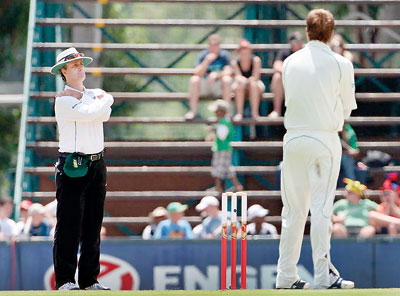Law is an ass, but cricket laws are jackass
View(s):In those early days of cricket, when the shepherds played a game which they called cricket, the basic rule for a batsman to get out was the ball hitting the wicket. The wicket was the gate to their meadow where they herded their sheep.
Four hundred years hence we do accept that the game has evolved, to the level of a professional sport played by a variety of people all around the globe.
But, still what I cannot understand is how they could say that a batsman is not out when the ball is hitting the wicket. May be it was it was an ICC committee led by mercurial Sunil Gavaskar or cricket’s any other demy- god who thought of this idea, but, to this mundane me it is sacrilege.
After they lost the second Test to Australia, Indian captain Mahendra Singh Dhoni complained on the same lines of my argument. Here he is talking about the usage of the old system which has no DRS. DRS was introduced to bring the game into this millennium, wasn’t it? Can you called it flawless from the way it is now?
Dhoni’s complaint was: “The 50-50 decisions were not going India’s way.”
The Indians, who are against using the decision referral system (DRS) in the four-match series, had a contentious umpire’s call with the dismissal of Ravichandran Ashwin in India’s second innings of the second Test. Ashwin was given out caught behind off Mitchell Starc for 19 even though replays showed the ball hitting the top of his pads.
Dhoni stoutly defended India’s reluctance to use technology to aid in umpire’s decision-making, but said that his team was getting more bad calls than Australia in the series.
 “There’s a lot of 50-50 decisions that are not going in our favour,” he said.
“There’s a lot of 50-50 decisions that are not going in our favour,” he said.
“We’re on the receiving end more often than not. What happens in DRS, even if the DRS is around, those (contentious) decisions won’t go in our favour. DRS is used often to justify the decision that’s given by the umpire.
“What’s important is to use DRS as a way of giving the right decision irrespective of if the umpire has given it out or not out. There are a lot of ways to use DRS. This is something that needs to be put in a specific way. You’re adding too many variables to the game.”
I am no fan or a follower of Dhoni’s preaching. But, what I cannot understand is how the system can bend the rule to defend the integrity of an umpire about his rulings. At the same time, we feel that even though DRS and other concepts have been introduced to the game, still there are chances for an umpire who is in top of the game, to be dishonest or getaway after giving an intentional, slanted ruling.
The now prevailing system in game, where DRS is in operation, the rule mostly goes by the umpire’s original decision. If he says not out, the seam had to hit the stump 50% inside the stump, to reverse his ruling. If not it stays.
In the early days, right or wrong, cricketers had to abide by the umpires’ ruling. Yet, it was a blanket rule. But, now as the game is becoming more professional and there is more at stake, the ICC through the recommendation of its cricket committee has brought in certain rules to add more transparency and quality into the game. But, has it been done that way?
Just imagine the ball hitting a certain spot on the turf and coming in and hitting a batsman on the back foot and the umpire ruling the batsman out. Sadly the ball is only clipping the wicket and for the batsman who was struggling for survival after a few bad games, it becomes the end of the road. Because the umpire was right even if the ball was clearly dislodging the bails and the ball was hitting the wrong half of the stump.
Then in the same game, when the other side is batting the ball hits the same spot of the turf, and the umpire rules not out, the fielding side takes the review and the ball is hitting the very same spot of the stump that it was hitting before, but, the umpires ruling is 50% wrong this time, and, the batsman survives. Then the batsman goes onto score a century and his side wins the match because the umpire was 50% wrong in his decision, but the system backed him to do so.
However, cricket is not a game that portrays the umpires or for that matter any member of the side who are fielding at a given moment. It is a contest between a batsman and a bowler — trying to test their wits at the game while all the others on the field are aides for them to complete that task.
Jerome Jayaratne, head of the Max Academy and head of Sri Lanka Coaching, endorses this argument. He is of the view that if a decision is referred for review, the third umpire who had all that modern technology around him should be able to give his opinion as the final ruling irrespective of what the on-field umpire’s decision was. He has to say sorry this is the way it happened or I do agree with your decision. Yet, there should be no room for ambiguity. ICC has no right to shield the umpires’ interests by bending its rules.
My friend Mahinda Wijesinghe who is a world famous cricket historian and a celebrated cricket author also has a good argument on this issue. He too agrees that the current status quo is lopsided. The umpires keep looking at the Lbw scenario with a tunnel vision.
He argues that this embarrassing situation could be overcome if the umpires begin to look at the scenario in a broader perspective. The umpires must only ascertain the breadth of the ball and make sure that even the outer half of the ball would have clipped the stump.
If they are wrong, always the DRS is there to put things right – twice in an inning — every eighty overs. Not a bad count at all.
Another controversy also lies in the DRS issue. Right now India does not keep its date with DRS. In that scenario I feel international cricket once again is lopsided. The Indians still go with that DRS-less Stone Age theory, where the umpires could bail a batsman out with more freedom than umpires who are bound by the DRS laws.
Then the statistics could not remain the same. The plain reason is that ruling of an umpire is counted in two different manners. Then the ICC should adopt a method of grading individual players and match results in two different systems – games with DRS and games without DRS.
What if it was Bangladesh which initially decided to oppose DRS and said that all matches that they involved with will not have the ICC introduced system of DRS? Would have they still been in the game?
Then there is this ball pitching outside the leg stump or the off stump. It is a huge not out even if the ball is crashing into the base of the middle stump in the case of the ball pitching outside the leg stump. Why? The interpretation can say anything, but the ball was clearly outside the scroll shown on the DRS television shots, but, in reality there are no scrolls. Once again we argue that if the ball beats the bat and hits the stumps, the batsman is out. Then if the batsman was crafty enough to meet the ball outside the off stump with the pad, he is not out. Then on the leg stump even if the ball hits the base of the pads right in front and the ball is outside the scroll it is not out.
They say the law is an ass. But, some of the cricket laws are absolute jackass.


